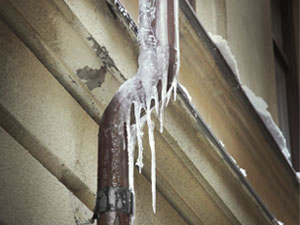
Establishing “Why” Since 1966
Dr. Robert Hartwig, President of the I.I.I. and an economist noted that, “winter storm claims, including those associated with freezing and ice damage, accounted for 7.1 percent of all insured catastrophe losses between 1993 and 2012, placing it third behind hurricanes and tropical storms (40 percent) and tornadoes (36 percent) as the costliest natural disasters.
On an inflation-adjusted basis, insurers paid $27.8 billion in winter storm claims to policyholders over this period—or $1.4 billion per year, on average, according to Property Claims Service for Verisk Insurance Solutions.
Why pipes burst
When water freezes, it expands in volume by about 9 percent. And it expands with tremendous force: The pressure inside pipes may go from 40 pounds per square inch to 40,000 pounds per square inch. No commonly available pipe can hold that much pressure, so it splits open. The split may occur where the ice forms, but more often, it occurs where the internal water pressure finds a weak spot in the pipe’s wall that may be inches or even feet from the actual frozen area. For a burst to happen, the water cools a couple of degrees lower than freezing in the pipe, causing ice to form. Just one burst pipe in a home running at 4-8 gallons a minute from a burst pipe can do tens of thousands of dollars damage in a manner matter of minutes, let alone the cost of mold mitigation that may be required.
Temporary steps to thaw frozen pipes
The first sign of ice forming in pipes is often noticed as reduced flow from a faucet. So if the flow slows to trickle during a cold snap, or if you suspect your pipes are vulnerable, it is important to take action. Here are a few things you can do:
- Turn up the heat.
- Set up fans to blow heat into cold rooms.
- Open vanity or cabinet doors so warm air can reach the pipes under sinks.
- If you have exposed pipes inside closets or pantries, leave doors open.
- Disconnect garden hoses from outdoor faucets. Even “frost-proof” faucets can burst if a hose is connected.
- Keep the garage door closed.
- If you have reduced water flow, heat the most vulnerable pipes (usually in basements and crawl spaces or near exterior walls) with a hair dryer. Leave the faucet on while you apply heat. As you melt ice, the flow will increase.
Prevention
- Locate and identify any and all shut off valves in your home and make sure they work- Everyone should know where their “Main water valve” is and how to operate it;
- Identify any potential problems- Areas where pipes may be on outside walls, ceiling, crawl spaces, attics, etc.;
- Seal any gaps around the home where cold air may penetrate and become in contact with piping. In the severe cold, especially associated with strong winds, even a tiny opening can let in enough cold air to cause a pipe to freeze- Seal gaps around dryer vents, windows, cable penetrations, etc;
- Turn off and drain all standard outside hose bibs.
Forensic Analysis & Engineering’s Nationwide team of Professional Mechanical and Civil Engineers can help you, wherever you loss may be by performing detailed investigations of the home or commercial building to determine why and how an ice related failure occurred and at the same time advise what needs to be done to prevent it from occurring again in the future. FAEC provides clear, concise, and unbiased reports to give you the information you need to resolve your loss. To find out more or to submit an investigation request, visit our website at https://www.forensic-analysis.com.

Recent Comments